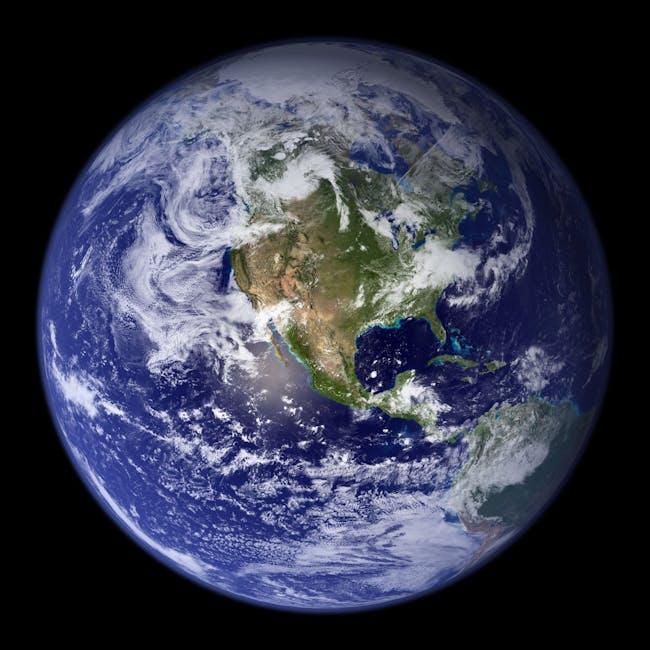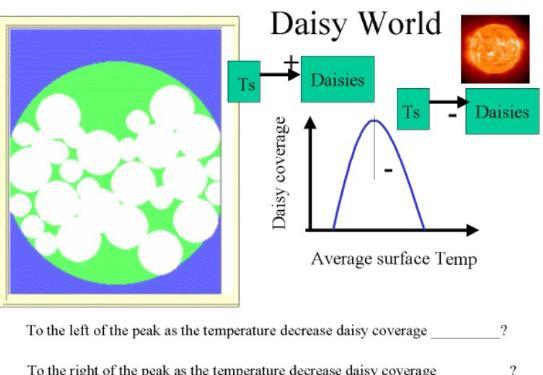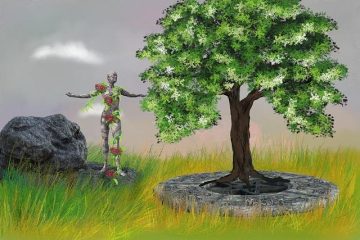Table of Contents
- Understanding the Gaia Theory and Its Relevance to Ecology
- Exploring the Daisy World Model and Its Implications for Climate Change
- The Interconnectedness of Biodiversity and Ecosystems in Gaia Theory
- Practical Applications of Daisy World in Environmental Management
- Future Directions for Research and Conservation Inspired by Gaia Principles
- Q&A
- Concluding Remarks

Understanding the Gaia Theory and Its Relevance to Ecology
The concept that Earth operates as a cohesive, self-regulating entity is rooted in the Gaia Theory, first introduced by scientist James Lovelock. This revolutionary perspective reveals how living organisms and their inorganic surroundings are intertwined, with each influencing the other in a delicate balance. At its core, the theory suggests that life not only exists on Earth but actively participates in maintaining the conditions necessary for its own survival, thus presenting a holistic view of life on our planet.
A compelling illustration of these dynamics can be found in the “Daisy World” model, which simulates the interactions between two types of daisies—black and white. In this simplified ecosystem, the different colors of daisies absorb varying amounts of solar energy, which significantly impacts the planet’s temperature. As daisies flourish, they modify their environment, creating a feedback loop that stabilizes the climate within the model. This illustration underscores the profound interconnectedness of life forms and their habitats, revealing how even minute changes can lead to substantial effects in ecological balance.
Recognizing the implications of this model is essential for understanding ecological stability and promoting conservation. Here are a few critical takeaways:
- Synergy of Life: The interactions among living organisms and their environments continuously shape and influence each other.
- Dynamic Feedback Loops: Changes in species populations can lead to cascading environmental effects, emphasizing the importance of biodiversity.
- Sustainable Practices: Protecting diverse ecosystems is vital for ensuring the planet’s health and resilience against environmental changes.
Exploring the Daisy World Model and Its Implications for Climate Change
The Daisy World model, conceptualized by James Lovelock as part of his Gaia Theory, offers a fascinating insight into the interplay between life and the environment. At its core, this model illustrates how a simple ecosystem of black and white daisies can maintain a stable climate, despite fluctuations in solar energy. The black daisies absorb more sunlight, warming the surrounding area, while the white daisies reflect sunlight, helping to cool it. This feedback mechanism demonstrates how living organisms can influence their environment, a fundamental principle of Gaia Theory that posits Earth itself operates as a self-regulating system.
Implications for climate change are profound when considering how ecosystems like Daisy World function. As global temperatures rise, the balance of species can shift. A rise in temperature favors black daisies, leading to an increase in their population and further warming the climate. Conversely, if black daisies dominate too much, the resulting higher temperatures could lead to their decline due to overheating, showcasing a delicate balance that mirrors real-world ecosystems. Such dynamic interactions highlight the potential for biological responses to climate change and underscore the need for continuous research into how species adapt to shifting environmental conditions.
To better understand the consequences of shifts within the Daisy World model, consider the following factors:
| Factor | Effect on Climate |
|---|---|
| Temperature Increase | Favors black daisies, exacerbates warming |
| Decreased Biodiversity | Reduces resilience to climate shifts |
| Pollution | Affects daisy growth and reproductive success |
This model serves as a microcosm for understanding the delicate balance of our own ecological systems and the urgent need to address climate change. By recognizing how different factors influence this balance, scientists and policymakers can gain valuable insights into developing strategies that promote sustainability and resilience in the face of environmental challenges.

The Interconnectedness of Biodiversity and Ecosystems in Gaia Theory
At the heart of Gaia Theory lies the intricate balance between biodiversity and ecosystems, a relationship often illustrated through the concept of a “Daisy World.” This model proposes a planet where two types of daisies exist: white and black. White daisies reflect sunlight, while black daisies absorb it. As environmental conditions change, the ratios of these daisies shift, demonstrating how species adaptations influence ecosystem dynamics. This delicate interplay reveals how biodiversity stabilizes the environment, ensuring resilience against climate fluctuations.
In a thriving ecosystem, biodiversity contributes not only to stability but also to productivity and sustainability. The varied interactions among species — including pollination, nutrient cycling, and predator-prey dynamics — are crucial for maintaining ecological balance. Consider the following aspects of this interconnected web:
- Pollination: Bees, birds, and bats depend on diverse plant species, which in turn nourishes various animal populations.
- Nutrient Cycling: Decomposers like fungi and bacteria break down organic matter, enriching the soil for new plant growth.
- Resistance to Invasions: Higher biodiversity reduces the likelihood of invasive species taking hold and disrupting the ecosystem.
The Daisy World model poignantly illustrates the profound effects of these interactions. For example, an increase in black daisies may initially raise local temperatures, leading to a decrease in their population as whites thrive in the newly warmed conditions. This feedback loop emphasizes the importance of maintaining biodiversity, as the loss of even one species can ripple through the ecosystem, altering its structure. The balance that Gaia Theory promotes is not just idealistic; it is an ecological necessity, underscoring the delicate relationship between organisms and their environment.

Practical Applications of Daisy World in Environmental Management
One of the compelling is its ability to illustrate the intricate balance of ecosystems and the benefits of biodiversity. By analyzing how different species—represented by black and white daisies—respond to temperature variations and sunlight, environmental managers can gain insights into the crucial roles species play in maintaining equilibrium. This model encourages the promotion of a diverse range of species, as higher biodiversity typically enhances resilience against environmental changes and stresses.
Moreover, the Daisy World simulation can serve as a powerful educational tool in understanding climate change impacts. Through interactive models, educators and students can visualize how changes in climate variables affect species survival and distribution. This hands-on approach fosters awareness and prepares future generations to confront environmental challenges. Key components for effective educational use could include:
- Interactive simulations for engaging learning experiences
- Case studies demonstrating real-world applications
- Collaborative projects that encourage critical thinking
policymakers can utilize insights gained from Daisy World principles to inform sustainable development strategies. By recognizing the interconnectedness of species and their environments, they can devise regulations that aim to mitigate risk factors threatening biodiversity. Potential policy strategies might comprise:
| Strategy | Benefits |
|---|---|
| Sustainable Habitat Management | Preserves essential ecosystems |
| Promotion of Green Spaces | Enhances urban biodiversity and health |
| Climate Adaptation Policies | Boosts resilience to climate change |
Through these applications, the concepts derived from Daisy World can profoundly influence environmental management, fostering a holistic approach that acknowledges both species interdependence and the necessity for sustainable practices.

Future Directions for Research and Conservation Inspired by Gaia Principles
As we look to the future of research and conservation through the lens of Gaia principles, several exciting avenues emerge. These include the exploration of holistic ecosystems, where the interdependence of species is critical to understanding the resilience of our planet. Postulate models that integrate complex interactions among organisms could lead to innovative conservation strategies that mimic natural processes. This holistic viewpoint encourages a multidisciplinary approach, incorporating insights from ecology, sociology, and environmental science.
Community engagement plays a vital role in interpreting and applying Gaia principles in conservation efforts. By fostering a collaborative atmosphere that embraces citizen science, researchers can amplify their data collection capabilities. Engaging local populations not only empowers communities but also gathers diverse insights on environmental conditions. This collaboration could involve initiatives such as:
- Developing local observation networks to monitor biodiversity.
- Creating educational programs on sustainable practices.
- Implementing restoration projects in degraded areas.
employing technology for biodiversity monitoring represents a key future direction. Tools like drones, remote sensing, and artificial intelligence provide unprecedented opportunities to study ecosystems at a scale previously unattainable. These technologies can help in:
| Technology | Application |
|---|---|
| Drones | Mapping and surveying large ecological areas |
| Remote Sensing | Tracking land use changes and habitat fragmentation |
| AI Algorithms | Predicting species distribution and identifying threats |
This blend of technology with Gaia-inspired methodologies positions us to enhance conservation efforts significantly, ensuring a sustainable balance within our ecosystems for generations to come.
Q&A
Q&A: Understanding the Gaia Theory and the Daisy World Model
Q1: What is the Gaia Theory?A: The Gaia Theory, proposed by scientist James Lovelock in the 1970s, posits that Earth functions as a self-regulating system. It suggests that the planet’s biological and physical components interact in ways that maintain conditions conducive to life. Essentially, the theory views the Earth as a single organism, where living and non-living entities collaborate to sustain the environment.Q2: What is the Daisy World model, and how does it relate to the Gaia Theory?A: The Daisy World model is a hypothetical scenario that illustrates the principles of the Gaia Theory. Created by Lovelock and Andrew Watson, it features a world populated by white and black daisies. In this model, the daisies affect the planet’s temperature by reflecting or absorbing sunlight. The model demonstrates how life can regulate climate conditions—showing that as the planet warms, white daisies thrive because they reflect sunlight and cool the surface, while black daisies, which absorb heat, decline. This feedback loop highlights the interconnectedness of living organisms and their environment.
Q3: How do the daisies influence the climate in the Daisy World model?A: In Daisy World, the presence of daisies influences the planet’s albedo—its ability to reflect sunlight. White daisies, with their reflective petals, help to cool the environment by bouncing sunlight away. Conversely, black daisies absorb more sunlight, raising the planet’s temperature. The balance between these two types of daisies creates a feedback mechanism that regulates the temperature of Daisy World, illustrating how biological life can impact its surroundings and maintain habitable conditions.
Q4: What are the implications of the Daisy World model for understanding environmental stability?A: The Daisy World model serves as a simplified illustration of how life forms can collectively create a stable environment. It emphasizes the importance of feedback loops in ecological systems, where species interact with each other and their surroundings. The model implies that biodiversity is crucial for maintaining ecological balance, suggesting that healthier ecosystems are more resilient to changes in climate and other external pressures.
Q5: Can the Daisy World model be applied to real-world environmental issues?A: Yes, the concepts demonstrated in the Daisy World model can provide insight into real-world environmental dynamics. While Earth is far more complex than Daisy World, the interactions between various species and their environments echo the principles outlined in the model. It highlights the importance of conserving biodiversity and understanding ecological relationships to combat climate change and promote environmental sustainability.
Q6: What criticisms exist regarding the Gaia Theory and the Daisy World model?A: While the Gaia Theory has garnered both interest and support, it also faces criticism. Some scientists argue that it oversimplifies the complexity of ecological interactions and overstates the self-regulating capabilities of the Earth. Critics contend that viewing the planet as a singular organism can be misleading, as it may overlook the nuances and unpredictability of environmental systems. Additionally, the Daisy World model, while illustrative, is a simplified abstraction that cannot entirely capture the intricacies of our actual ecosystems.
Q7: How does the Daisy World model enhance our understanding of climate change and its effects on life?A: The Daisy World model highlights the reciprocal relationships between life and climate, shedding light on how fluctuations in environmental conditions can disrupt these relationships. By illustrating feedback loops, it helps us understand the potential consequences of climate change on biodiversity. It encourages us to consider how changes in one species or environmental factor can ripple through an ecosystem, adversely affecting various life forms and ecological stability.
This Q&A provides a creative yet neutral exploration of the Gaia Theory and Daisy World model, presenting fundamental concepts while inviting deeper consideration of the intricacies of environmental stewardship.



0 Comments